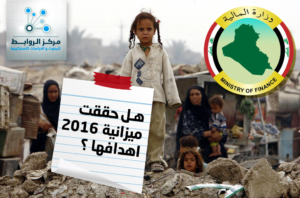The Budget is the financial plan developed by the state as an approach to be followed in the next year, and often it was released in the beginning of each year and it is the main important tool for managing of fiscal policy for any state .
The budget aims to identify the best ways to exploit the resources of the state and filling its expenditures without exposure to the debt and international loans, and the budget may be for a long – term that means for several years, or short – term so as to be annual.
It is a way or a general plan , both current and investment of spending and revenue , and the budget ‘s ability to cope with economic problems and address it was attributed to the philosophy of the state to intervene or not, if the state adopts the principles of the capitalist system to address economic problems such as Iraq does not intervene in solving economic problems.
If we review the difference between the budget and the balance for Iraq in
2016, we will find that Iraq ‘s revenues of the budget expected for 2016 amounted by 81,700,803,138 ( eighty one Trillion and seven hundred Billion , eight hundred and three million and one hundred and thirty – eight thousand dinars), and the earned incomes from the export of oil had been calculated at a price rate of (45 ) dollars per barrel of oil, calculates the dollar on the basis of (1116) Iraqi dinars, and the rate of export (3.6) million barrels per day , including production of the Kurdistan region and the production of the province of Kirkuk.
the anticipated budget for 2016 indicated that the total expenditure will reach 105,895,722,619 ( one hundred and five trillion, eight hundred and ninety – five billion and seven hundred and twenty – two million, six hundred and nineteen thousand of Iraqi dinars, of which
80,149,411,081 for current expenditures ,
25,746,311,538 for investment expenditures ,
and 69,773,400,000 for oil revenues
and 11,927,403,138 for non-oil revenues
and the total planned deficit 24, 194 919 481.
From the foregoing, the Iraqi budget structure suffers from several problems, operational spending consumes most of the budget revenues, noting that the percentage of operational spending to total revenue was reaching to 98.1%.
The member of parliamentary finance committee Majda al – Tamimi revealed about the total revenue and expenditure for the year 2016 up to the end of the last November , indicating that the amount of the deficit until this period amounted to more than 34 trillion dinars.
Tamimi added in a statement that ” the total expenditures for 2016 totaled up to November 60 Trillion month and 420 billion and 643 million dinars.
She added that the current expenditures reached to amount 47 trillion and 568 billion and 568 million dinar while the investment expenditures reached 12 trillion and 852 billion and 75 million dinar in return for oil revenues amounted 29 trillion and 741 billion and 992 million dinar that part of it goes to the foreign oil companies( rounds of licenses ) by amount 8 trillion and 679 billion and 915 million dinar that the net oil revenues to reach by 21 trillion and 92 billion and 78 million dinar whilethe non-oil revennued amounted 4 trillion and 848 billion and938 million dinar that the total of oil revenues and non-oil revenues to reach 25 trillion and 911 billion and 16 million dinar .
Al- Tamimi called to “conduct a detailed review of total expenditures and in a professional manner away from the political, partisan and sectarian influences, and to engage in spending details for some of the paragraphs to be reduced or deleted, and reconsider the travel and deputations and expenses of fuel , and develop appropriate mechanism for the auction of currency and to accountable the corrupt who control of the border crossings , and take hold on the bulk of its revenue compared to a proportion not be remembered going to the state treasury.
The following table shows the difference between the planned balance and actual budget for the year 2016
values / Iraqi dinar
This reflects the fragility of the Iraqi economy because of wrong economic policies and the lack of clear strategic vision , which played a major role in the squandering of massive oil revenues after 2003 and international and regional powers devoted the unilateral economy and rentier economy of the Iraqi state , that agendas of internal currents and forces were behind it aimed at keeping Iraq weak country racked by various conflicts , supported by the sectarian and quota system and the conflict of interests and financial and administrative corruption, which led to the collapse of the productive base of the Iraqi state including public and private industrial , mixed and cooperative sector and agricultural sector, as well as artisan sector.
As a result of corrupt economic conditions , we get to the important result of which is that the budget has not been and will not be able to address or alleviate any of the accumulated crises from previous budgets , such as the crises (housing, unemployment, illiteracy, poverty rate, municipal services, school buildings , dropout and evasion of education , health services , and cadres).
Shatha Khalil
Translated by : Mudhaffar Kusairi
Unit of Economic Studies
Sources:
Http://mawdoo3.com
http: //www.s Http://www.daleeliq.com Otaliraq.com7
Dr. / Magda Tamimi site
Rawabet Center for Research and Strategic Studies

